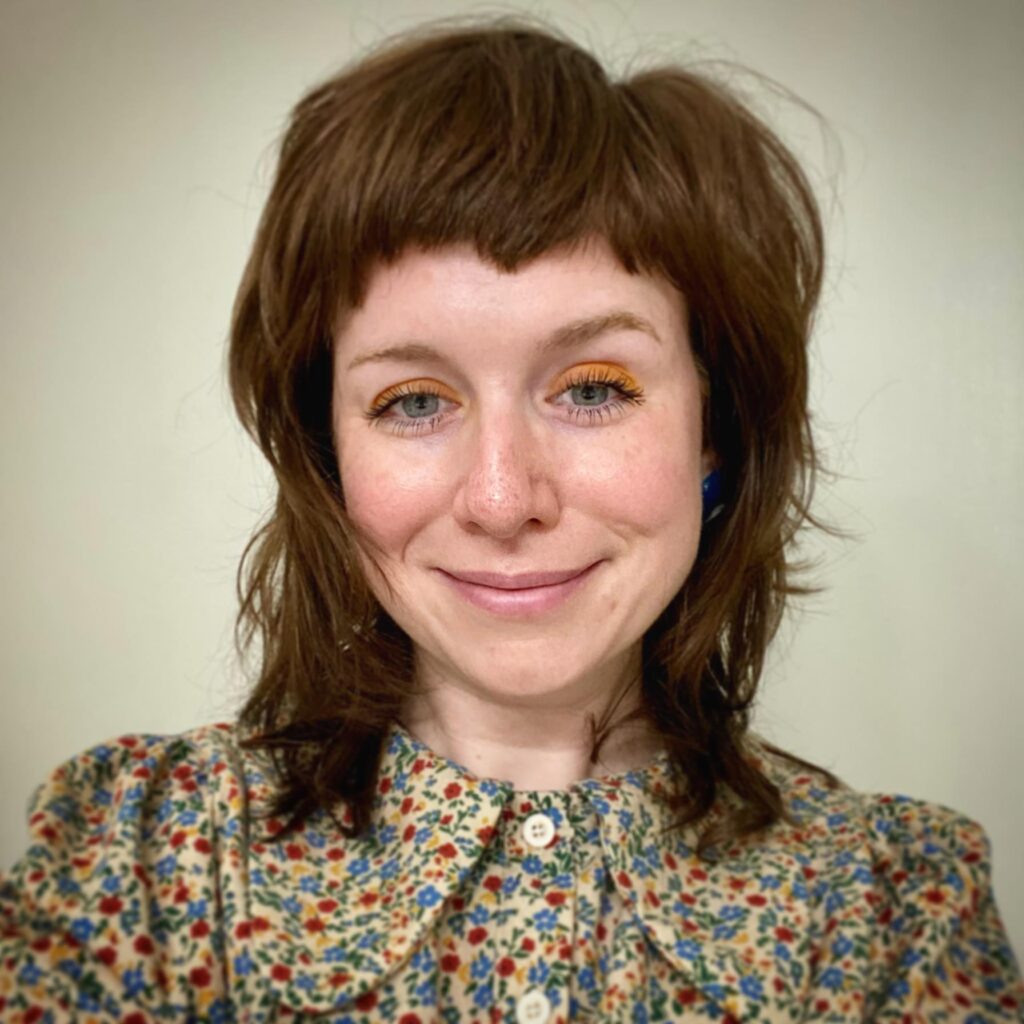
Kelly Gallagher is a filmmaker, animator, and Associate Professor of Film at Syracuse University. She is the recipient of a 2024 Creative Capital award. Her handcrafted films and commissioned animations have screened at venues including: the Museum of Modern Art, the National Gallery of Art, Sundance Film Festival, Tribeca Film Festival, and the Smithsonian Institution. Recent commissioned animations have screened on Netflix and PBS. She’s presented solo programs of her work at institutions including: SFMOMA, Close-Up Cinema London, SF Cinematheque, and Wexner Center for the Arts. Kelly enthusiastically organizes and facilitates fun and inclusive film workshops and camps for communities of all ages, from Kentucky to California, from New York to Iowa and beyond.
ARTIST STATEMENT
I am an experimental filmmaker and animator based in Syracuse, New York. I am interested in handcrafted filmmaking and exploring the ways in which experimental and handcrafted animations make labor visible, aesthetically gesturing towards the workers behind their production. I am invested in exploring the ways in which experimental and handcrafted animation forms and techniques can be utilized to address political inquiries and concerns, and stories of resistance. I understand that as filmmakers we are also producers and laborers (per Benjamin’s Author as Producer), and as such, I aim to weaponize my filmmaking skillsets against capitalism. As Benjamin noted: “[the] apparatus is better, the more consumers it is able to turn into producers-that is, readers or spectators into collaborators.” With this in mind, many of my films are intentionally essayistic and collagist in nature, inviting viewers to collaborate in the process of making meaning of the films’ content, questions and ideas. Finally, I am intrigued by the political possibilities of collage and its ability to call attention to the mediation of its production.
The primary objective of my creative research agenda for the past fifteen years has been to formally experiment with collagist approaches to filmmaking and animation, to effectively share and probe histories of radical political resistance. As a former union organizer and person committed lifelong to struggles against white supremacy, colonialism and capitalism, I’m invested in the work of studying history in order to understand concrete strategies of organizing and resistance that may work best for us in the present. When I helped organize workers in a workplace, their success was contingent on the ability for individuals to not feel alone in their struggle, and to see others fighting alongside them for a better future. I’m invested in visualizing resistance because seeing images of people resisting reminds us importantly that (A) we are not alone and (B) we, ourselves, have the capacity to fight back. Seeing Lizzie Borden’s Born in Flames as a young college student deeply impacted my trajectory as a filmmaker. It was the first time I saw collective organized feminist resistance against sexual assaulters and misogyny so explicitly on screen. It was revelatory. I felt encouraged by the women on screen fighting back against sexual harassers. I felt connected to them through their confrontations and struggles. Film as confrontation and visualized resistance is imperative for me in my work because by creating visual representations of a world in which our impact ruptures capitalism and systemic patriarchy and racism, we are reminded that such a world can in fact exist and that our political efforts are not in vain but are in fact imperative.
With my goal of making political resistance visual, I make colorful collage films, experimental films, documentaries, and found footage essays. Some films of mine explore the deeply personal and diaristic. For my handcrafted animation work, I construct paper cut-out collages, supplanting traditionally feminine imagery (flowers, glitter, nail polish) for employment in means of militant resistance. (The desire to make militant resistance more aesthetically feminine is inspired by my exhaustion and frustrations as a former labor organizer with predominantly macho and masculine coded representations of U.S. labor history.) I animate my collages on a multi-tiered system of glass panes, utilizing everyday objects and available materials. Alongside cut-out collage animation, I also work with 16mm, super 8mm, and HD live action filmmaking. Additionally, I often work with found footage of various kinds in my films. As a collage filmmaker, I am inspired by Walter Benjamin’s idea that “the work of memory collapses time.” I seek to make the collapse of time visual, bringing events from our past up against the present to explore what can be learned from histories of resistance and perseverance today. (History is ongoing, after all). My collage of formal aesthetic approaches is intentional. As William Wees writes in Recycled Images, collage is political: it actively promotes a critical analysis of why an artist brings various elements together. For me, the power of oscillating between analog produced visuals alongside tactile animation, contemporary HD and other mixed media visual elements is that it helps promote an aesthetic kinship linking us today in the present with our historical past. IE: a viewer may wonder if a super 8mm scene is historical even though the VO that goes with it tells a story from the current moment. This approach is inspired by Walter Benjamin's "On the Concept of History." Benjamin emphasizes the importance of drawing the past into now. Instead of the past being some temporal distant point far away from us, Benjamin argues for us to have a historical materialist understanding of the past: to visualize it as an image subsumed in the present, one whose material, social and political conditions are still present today.
Three major influences of my creative research are: Emory Douglas, Lizzie Borden, and Helen Hill. As previously mentioned, Borden’s work taught me the power and importance of crystalizing resistance in the moving image format. Emory Douglas’ writings have taught me the importance of making radical art radically accessible to the masses (most of my work streams online for free). And Helen Hill’s life perpetually inspires me to live generously and make the processes of filmmaking and animation accessible to all those in my community, especially outside the confines of the university. Much of this has resulted in numerous free workshops I facilitate regularly, especially with children, around inclusive and accessible film and animation practices (both in my own city and around the country).
By primarily using filmmaking and animation tools that are easily accessible (paper, glitter, paint, magazines, scissors, found footage), I also attempt to call attention to form and inexpensive and accessible practices for filmmakers. Creating film/video works that use tools readily available to many is important to me because I firmly believe culture should be both accessible to all and created by all who are interested.
